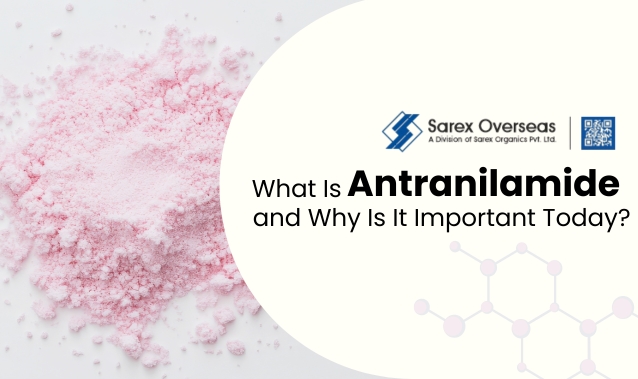Antranilamide, or 2-Aminobenzamide, has stealthily become the most lucrative of the fine chemicals in the contemporary industrial world. It's a key component in the fields of packaging, coats, dyes, pharmaceuticals and even biotech research.
With industries seeking safer chemicals that are also efficient and globally harmonious, this compound finds itself time and again proven useful. Knowing what it is and how it operates paints a vivid picture of why so many industries depend upon it today.
Exploring Antranilamide from the Inside Out
Antranilamide is a crystalline, pink to off-white powder that has a molecular weight of 136.15 g/mol and the chemical formula C₇H₈N₂O. It has a melt between 110 - 114°C and dissolves to a clear solution when treated in methanol 2.5 % Wt/V. It has a very good purity that gives an assay of not less than 98 % by potentiometric titration.
It is registered worldwide by CAS No. 88-68-6 and EC No. 201-851-2. It is listed in the European EINECS, US TSCA, Korean KECL, Japanese ENCS and Chinese IECSC, so it is safe internationally. It is non-hazardous under most regulations but may be an irritant or mild corrosive when in a concentrated version.
A Game-Changer for PET Bottles Packaging
In the pet world, Antranilamide has established itself as a scavenger for acetaldehyde for PET. Heats during PET processing cause the formation of this volatile substance called acetaldehyde that may migrate from bottled beverages such as soft drinks or bottled water and change their flavour. This problem is prevented by the addition of Antranilamide.
Even in minuscule quantities, like 100 ppm, it reduces the level of acetaldehyde by approximately 46 % without having any impact on the clarity, colour or viscosity of PET. This performance has earned it a reliable addition for manufacturers that have stringent requirements for sensory and safe conditions.
Applications Beyond Packaging: Broad-Base Industrial Usage
The Antranilamide's flexibility goes way beyond its PET use:
- Dyes, Pharmaceuticals and Agrochemicals: Serves as an intermediate for pigments, pharmaceutical molecules and crop-protection molecules.
- Resins and Coatings: Used for the manufacturing of anthranilate esters, ionenaustaustoff-resines and modifiers for the alkyd-resin. Applied also for lacquer addition for the food grade.
- Antioxidants: It is also an antioxidant for greases, lubricants and unsaturated rubbers that increases their stability and end life.
- Biological Research: Fluorescently labels glycans containing a reducing terminus. The 2-aminobenzamide (2-AB) marker improves visibility during purification and analysis of biological samples.
Why Antranilamide Matters More Than Ever?
State-of-the-industry industries are faced with the challenge of balancing performance, sustainability and security. Antranilamide closes the gap. It improves the safe packaging of their products, aids worldwide compliance and improves the quality of their products in various industries.
Its reactivity as a reactive additive, chemical intermediate and analytical label makes it a foundation stone in the innovation of fine chemicals. Whether enhanced polymer performance, stabilised coatings, or new biological research, the compound continues the drive for practical advances.
Partner with Sarex for Reliable Quality
Sarex is one of India's most reliable names for quality and textile chemicals. The firm supplies Antranilamide of the highest purity and consistency that is designed for industrial purposes, research work and even for packaging. Being a one-stop marketplace for innovative and efficient chemical solutions, Sarex guarantees reliable supply, regulatory assistance and bulk manufacturing facilities.
For top-performance Antranilamide, reach out to Sarex to discover specs, talk about proprietary needs, or request.

